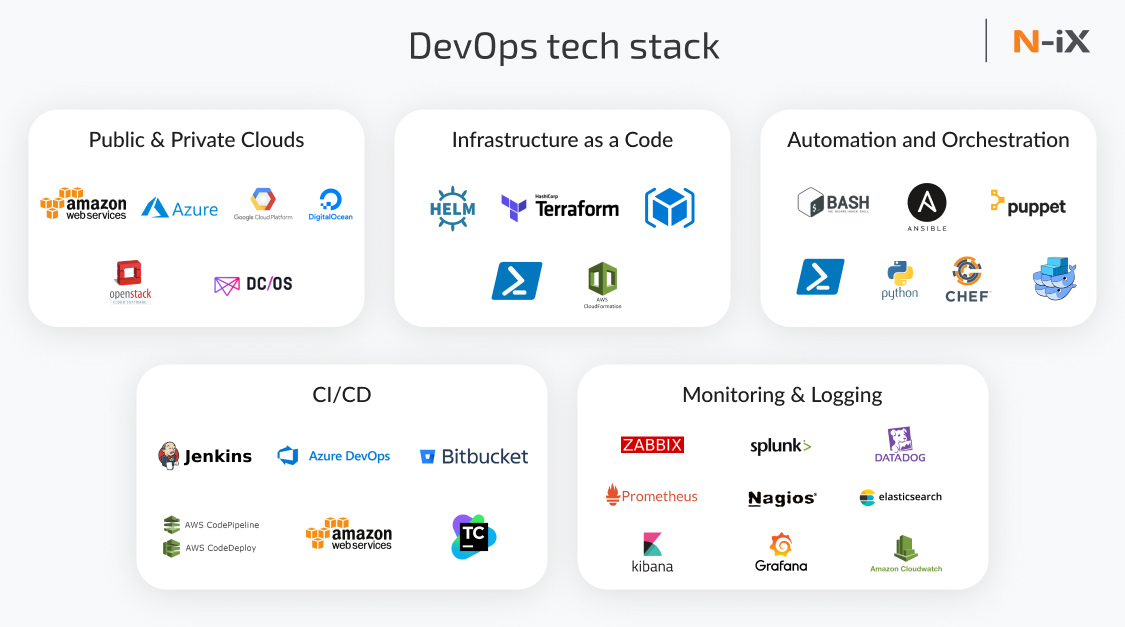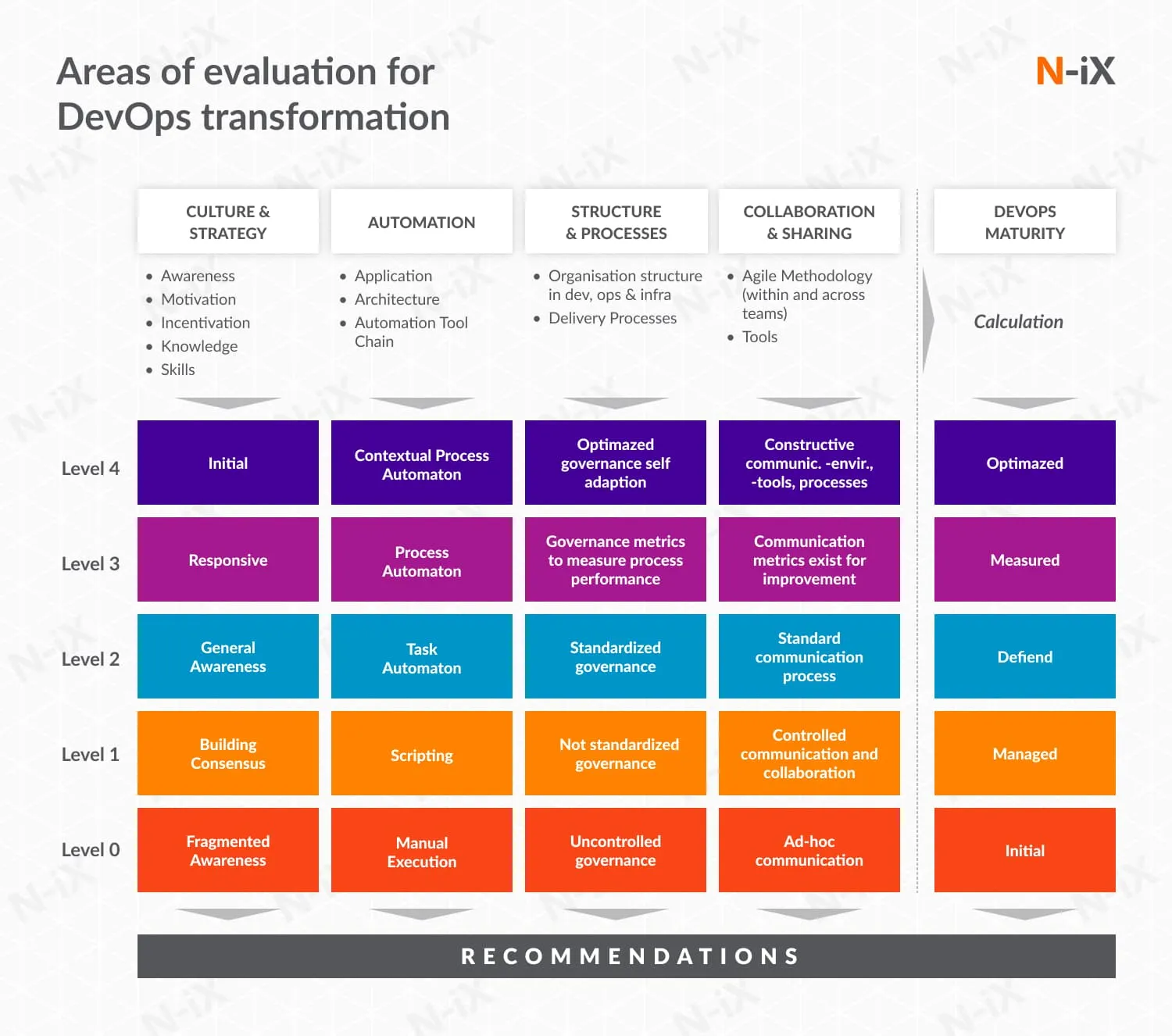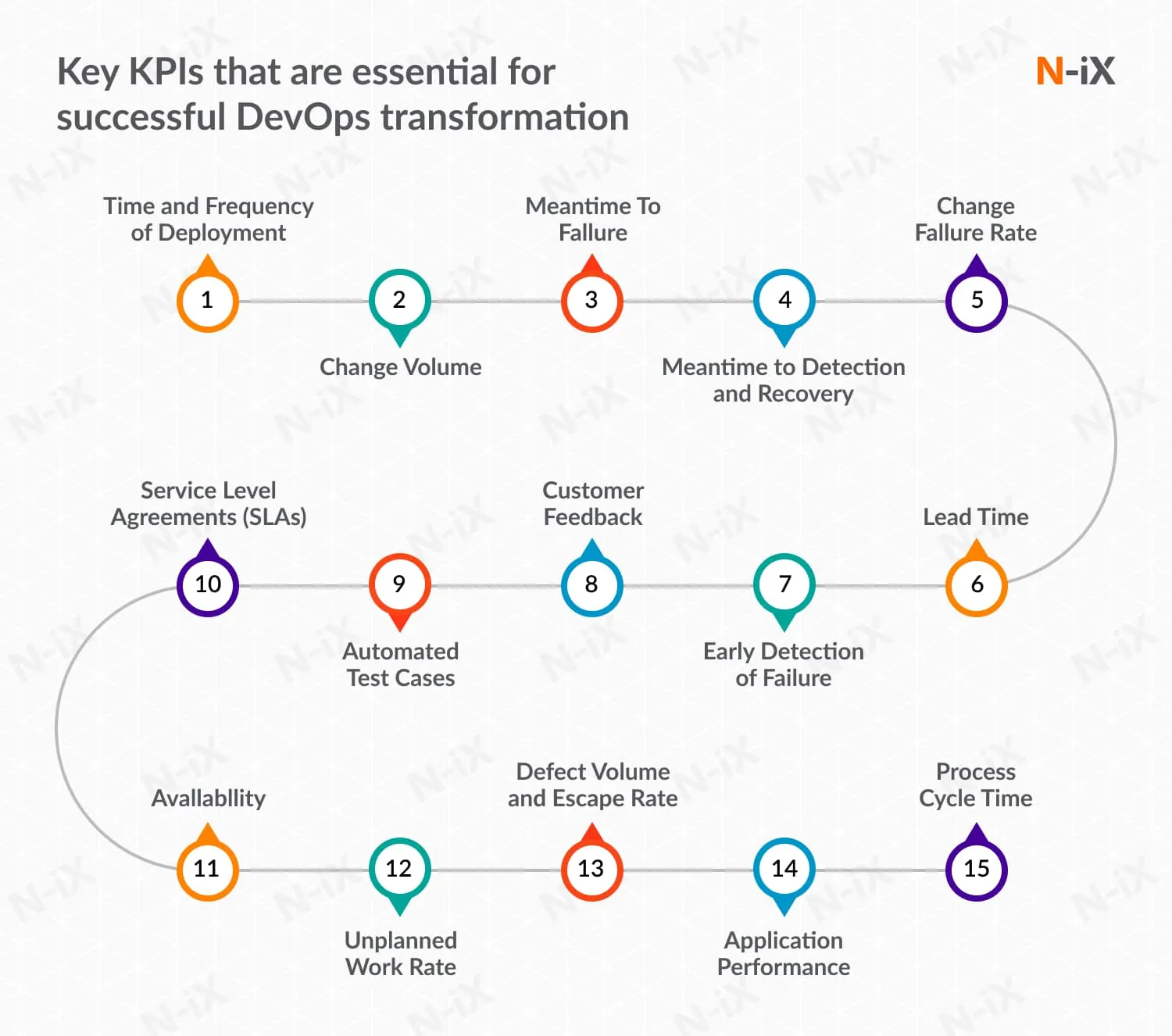DevOps transformation allows businesses to optimize costs and streamline their software solution delivery. Many companies, including such big names as Adidas, BMW, Disney, and Starbucks, have already fully embraced and benefited from their DevOps transformation strategy.
Nevertheless, the DevOps transformation journey is not an easy one, as there are many things you need to consider. How do you take full advantage of its benefits? What can you do to facilitate the cost optimization that it brings? And which steps do you need to take to successfully implement a DevOps transformation strategy? Read on to find answers to all of these questions.
The 4 key benefits of DevOps transformation
All benefits brought by DevOps transformation fall under the umbrella of one of the 4 key advantages:
- Flexible scalability. By properly utilizing various cloud services and resources, your DevOps engineers can help you quickly scale your software infrastructure to keep up with the needs of your business.
- Improved security. DevOps security (or DevSecOps) brings about the tools and methodologies that keep data safe.
- Faster solution delivery. The automation tools and practices applied during transformation reduce the amount of manual work and errors caused by the human factor, allowing your engineers to deliver bug-free solutions faster.
- Optimized costs. Finally, all aforementioned advantages help effectively allocate expenses, mitigate risks, and eliminate wasted costs.

How to optimize costs with DevOps transformation: 4 top solutions
With cost optimization being one of the key purposes of DevOps transformation, it is important to know what are the proper ways to achieve it.
Take advantage of third-party services
All leading cloud providers (AWS, Azure, and GCP) offer a wide range of services that DevOps experts can help you utilize. Using such services is very convenient, especially if you need to cover a straightforward need. You do not have to worry about maintaining or customizing the service and can use all of its features as soon as you pay for it.
Quite often, using third-party services is a much more cost-efficient alternative to developing them from scratch. Amazon RDS is a perfect example of an efficient third-party solution, as it offers all necessary features for database management straight out of the box.
However, even if you have to build a custom solution to cover a unique business need, DevOps experts can help you effectively combine them with the third-party services that you use.
When planning the architecture of your infrastructure, your tech partner will usually provide you with recommendations of the most efficient methods to cover each need. This, in fact, is one of the key attributes that indicate a reliable service provider.
Automate IT infrastructure provisioning and CI/CD processes
DevOps experts can deliver CI/CD processes and IT infrastructure to your developers as template-based solutions (or frameworks) by using the Infrastructure as Code (IaC) methodologies.
This approach automates IT infrastructure provisioning processes and frees up your developers’ time. Your engineers no longer have to perform IT infrastructure provisioning tasks manually, such as managing servers and data connections, and can focus on more high-value tasks. Furthermore, it allows them to reduce the time to configure and deploy services to just a few minutes.
Optimize the use of infrastructure resources
DevOps transformation often includes the development of solutions that enable automatic on-demand running of cloud infrastructure. These solutions are highly flexible and efficient in terms of both costs and time consumption, as they allow you to effectively manage the use of cloud infrastructure resources. For example, if you need to enable your cloud infrastructure for demo purposes, instead of running it continuously, you can enable it just for the time when you actually need it.
In addition to reducing expenses, these solutions also boost the development speed. They can be run with a scheduler and do not require your developers to launch them manually every time.
Optimize cloud resource costs
Cloud transformation providers offer a wide range of services and types of computing and storage resources that have different cost tiers. Let’s take E2C - a computing resource from AWS - as an example. It offers 4 different types of Instances that are suitable for particular types of tasks and, if properly utilized, help significantly optimize costs.
- On-demand. This instance involves paying for E2C resources by the hour and is perfect for short-term, irregular workloads.
- Reserved. These instances are offered with a significant discount as compared to On-demand (up to 72%) but are better used for long-running workloads.
- Spot. These are the cheapest instances that come with discounts of up to 90% and are useful in case you do not require high availability of your services.
- Dedicated. These are the most advanced (and expensive) instances that run on hardware designated for a particular customer. They fit perfectly for highly-sensitive workloads that require additional security and compliance.

Additionally, you can apply other best practices of using cloud resources to optimize costs even further. These include:
- Exploring hosting in other regions or availability zones;
- Moving storage that is rarely accessed to less expensive tiers;
- Deleting instances that are rarely used;
- Setting expenditure threshold alerts;
- Taking advantage of discounts.
Which tech expertise is required for successful DevOps transformation?
Since the transformation is a rather complex process that involves all branches of the solution delivery cycle, expertise in a wide range of tools and technologies is required. Whether you intend to build your own DevOps team or consider looking for a partner that can provide you with one, it should be skilled in the following areas:
- Public and private clouds:
- Azure, AWS, Google Cloud;
- DCOS Mesosphere, OpenStack.
- Infrastructure as a Code:
- AWS CloudFormation, Azure Resource Manager, Helm, PowerShell, Terraform.
- Automation and orchestration:
- Ansible, Bash, Chef, Docker Swarm, Kubernetes, PowerShell, Puppet, Python.
- CI/CD:
- Azure DevOps, AWS, Bitbucket Pipelines, CodeDeploy/CodePipeline, Jenkins Pipelines, TeamCity.
- Monitoring and logging:
- AWS CloudWatch, DataDog, ElasticSearch, Grafana, Kibana, Nagios, Prometheus, Splunk, Zabbix.
- Data centers:
- Hetzner, Rackspace, Unicept, etc.
- Infrastructure security:
- Firewall as a service: AWS SG, Azure NSG;
- Hardware firewall (such as Cisco ASA);
- Intrusion detection and prevention: OSSEC, Snort, Suricata;
- Web attack detection and prevention: AWS WAF, Azure Firewall, Application Gateway, etc.

How to implement DevOps transformation in 6 steps
The process of completing the DevOps transformation strategy can be split into 6 steps. Each of these steps requires careful preparation and execution but, if done correctly, guarantees positive outcomes.
Step 1. Perform infrastructure audit and evaluation
Before starting your DevOps transformation journey it is important to get a clear understanding of the state of your current infrastructure. A wise decision would be to entrust this step to your tech partners and provide the support they require.
An experienced partner can evaluate Culture and Strategy, Automation, Structure and Processes, and Collaboration and Sharing to calculate your organization’s overall DevOps maturity. Based on this they can provide a clear plan for your DevOps transformation journey, together with suggestions and technical recommendations on how to implement it efficiently (which third-party services to use, which solutions should be developed from scratch, etc.).
This step also provides a good insight into the expertise of your partner, as you get a chance to see them in action right from the start.

Step 2. Set up a DevOps Center of Excellence (CoE)
After performing the initial audit and obtaining the DevOps transformation roadmap it is important to set up a DevOps Center of Excellence.
This entity is responsible for accumulating, documenting, and sharing the knowledge that is of critical importance to the transformation. It also defines and standardizes the best practices that should be used by your organization and ensures that they are taught and practiced across all teams.
The main purpose of a CoE is to improve the performance of your DevOps teams, which results in quicker business innovation and faster time-to-market of your products.
Step 3. Establish KPIs and process governance
A set of key KPIs that are focused on business outcomes has to be established prior to starting your DevOps transformation strategy. Achieving these KPIs, which include, for example, time and frequency of deployment, unplanned work rate, defect volume, etc., ensures that your DevOps transformation strategy succeeds.
An effective DevOps culture makes meeting these metrics easier. To establish such a culture within your organization, make sure to streamline communication, clearly define roles and responsibilities, and share collaboration awareness between your teams.

Step 4. Set up project in-take
The clear project in-take process facilitates the speed and efficiency of each development sprint performed by your teams. Once the necessary DevOps tools and development methods have been selected, they need to be communicated to each team involved in the DevOps transformation process. Furthermore. Make sure to continuously gather feedback from all involved teams to evolve and improve your project in-take process.
Step 5. Run pilot programs
This step involves testing how the new DevOps pipeline operates. Identify a development process that will be tested (preferably the one that can be used as a model for scaling to the enterprise level) and apply the newly-established DevOps practices, tools, and methods. Analyze how the new KPIs compare to the existing ones and gather feedback from everyone involved in the development process.
Step 6. Scale your DevOps transformation process
Finally, use the information that you have gathered from the pilot program and apply the new DevOps transformation strategy to the rest of your delivery pipeline. Constantly gathering feedback and comparing metrics will allow you to continuously introduce new improvements into this pipeline, making it even quicker and more efficient.
Lebara - a successful DevOps transformation journey
Lebara’s partnership with N-iX is a perfect example of a DevOps transformation strategy done right. In a span of just several months the company was able to significantly improve the efficiency of its development processes, bringing about a range of benefits.
The challenge: a software development pipeline that lacked efficiency
Lebara approached N-iX with the task to optimize their existing delivery pipeline. The lack of appropriate automation tools required many things to be done manually, such as, assigning tasks or sending updates between the teams. As a result, the development process was prone to delays and errors caused by the human factor.
Moreover, additional difficulty was caused by the fact that Lebara was working with a live product used by millions of customers. This slowed down the development process even further and increased the time-to-market of Lebara’s new features and solutions.
The solution: using DevOps to transform the development pipeline
N-iX provided experienced DevOps engineers who performed an extensive evaluation of Lebara’s existing infrastructure and provided a detailed DevOps transformation roadmap.
The team then began to gradually introduce the tools, methodologies, and services into the pipeline as not to interfere with the ongoing delivery processes. Over the course of several months, the pipeline was completely transformed and many processes were automated, including communication, task assignment between the teams, and more.
The result: faster development and time-to-market
The DevOps transformation services provided by N-iX allowed Lebara to significantly increase the development speed and reduce the number of errors. As a result, the company now enjoys a faster time-to-market of their new products. If you are interested to learn more about our cooperation, head over to this page.
"Working with N-iX helped us go to market with new digital products quickly. Essentially, and very importantly, the partnership allows us to service our global migrant customers better wherever they might be," Chief Technology Officer, Lebara
Why choose N-iX DevOps transformation services?
- N-iX has formed long-lasting partnerships with many leading global enterprises, such as Lebara, Gogo, Fluke, and more;
- We have a strong team of 25+ DevOps engineers with expertise in cloud adoption, CI/CD integration, infrastructure automation, orchestration, monitoring, logging, and more;
- Our experts are proficient and officially certified in a wide range of technologies, including, AWS, Azure, Google Cloud, Kubernetes, Terraform, and many more;
- N-iX can be regularly found on various top service provider lists from platforms such as Clutch.co, Goodfirms, and The Manifest.



